How to Hand-Feed Koi Fish: Building a Bond Through Food
This post may contain affiliate links.
Have you ever watched your colorful koi glide through the water and wished for a deeper connection? Hand-feeding your koi isn’t just about providing nutrition—it’s about building trust, creating a meaningful bond, and experiencing the joy of interaction with these intelligent creatures. When koi take food from your palm, you’re not just feeding them; you’re establishing a friendship that can last for decades.
With patience and the right approach, you can transform your koi from distant swimmers to eager friends who recognize you and swim up to greet you. This guide will walk you through everything you need to know about hand-feeding koi fish, from choosing the right food to mastering the techniques that build lasting trust.
Why Hand-Feed Your Koi?
Hand-feeding creates a special bond between you and your koi that goes beyond the typical owner-pet relationship. These intelligent fish can recognize their owners, remember feeding routines, and even develop unique personalities that shine through during feeding time.
Beyond the emotional connection, hand-feeding offers practical benefits:
- Allows you to monitor each fish’s health up close
- Helps you identify any injuries or signs of illness early
- Enables you to ensure every fish gets proper nutrition
- Creates a calming, meditative experience for you
- Impresses friends and family with your koi’s friendly behavior
Most importantly, hand-feeding transforms your pond from a simple water feature into an interactive experience that brings joy and connection to your outdoor space.
Understanding Koi Behavior and Intelligence
Before you begin hand-feeding, it helps to understand what makes koi special among pond fish. Contrary to the stereotype of fish having three-second memories, koi are remarkably intelligent with impressive long-term memory capabilities.
Koi can remember people, routines, and feeding spots for years. Some pond owners report their koi recognizing them even after months of absence.
Koi intelligence manifests in several ways that affect hand-feeding:
- Social Learning – Koi learn from watching other fish, which is why one brave fish often leads the way in hand-feeding
- Pattern Recognition – They quickly associate your presence at certain times with food
- Spatial Memory – Koi remember feeding locations and return to them consistently
- Individual Personalities – Some koi are naturally bold, while others remain shy despite training
Certain koi varieties, particularly Chagoi (brown koi), are known for their friendly dispositions and often become the first to accept hand-feeding. These “leader” fish can help train your more timid koi through their example.
Preparing for Your First Hand-Feeding Session
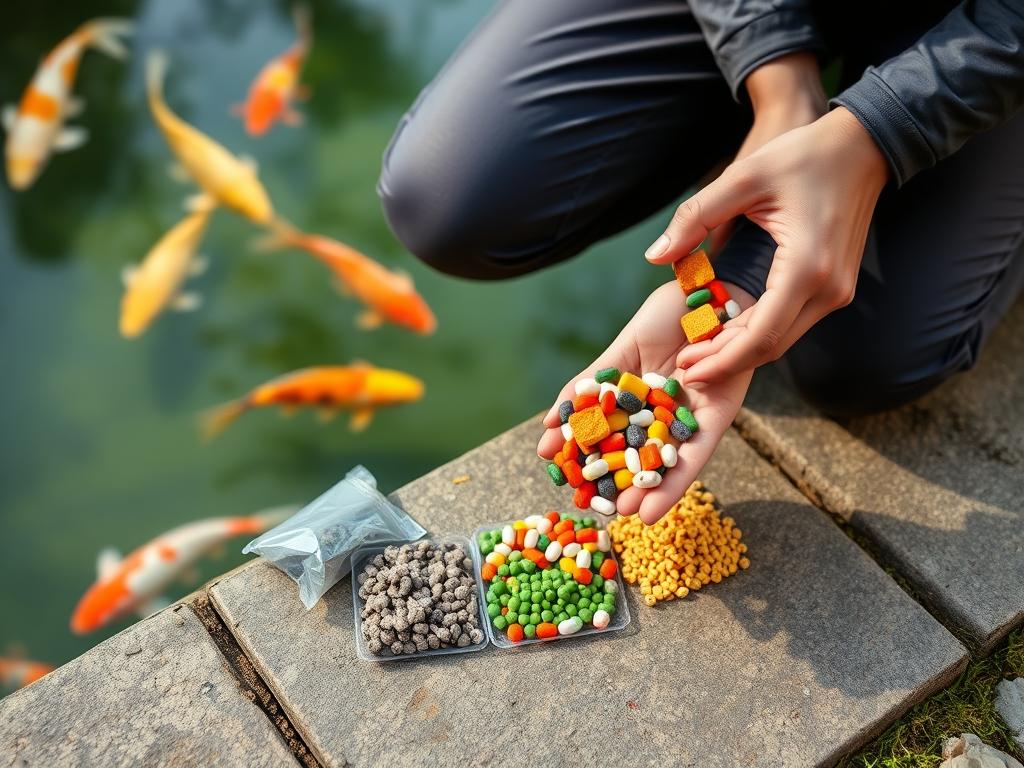
Choosing the Right Food
The food you offer plays a crucial role in successful hand-feeding. Koi are more likely to approach your hand when tempted by high-quality, aromatic food they find irresistible.
Best Foods for Hand-Feeding:
- Floating Pellets – Stay on the surface and are easy to control in your palm
- Koi Sticks – Larger and easier to hold between fingers
- Freeze-Dried Treats – Special options like silkworm pupae or krill that koi love
- Soft Fruits – Occasional treats like orange segments or watermelon pieces
Food Qualities to Look For:
- High protein content (35-40%)
- Fish meal as the first ingredient
- Contains krill or shrimp for enhanced flavor
- Floating formula that won’t sink quickly
- Appropriate pellet size for your koi
Quality Food Makes a Difference
For successful hand-feeding, choose premium koi food that contains fish meal as the first ingredient. Quality food not only attracts your koi but also supports their health and vibrant colors.
Creating the Ideal Environment
The setting and timing of your hand-feeding attempts significantly impact your success rate. Consider these environmental factors:
- Water Temperature – Koi are most active and hungry when water temperatures are between 65-85°F (18-29°C)
- Time of Day – Early morning or evening when temperatures are moderate
- Lighting – Avoid casting shadows over the pond that might spook the fish
- Water Quality – Clean, well-oxygenated water makes koi more comfortable and active
- Feeding Location – Choose a consistent spot that’s comfortable for you and accessible for the fish
Never attempt hand-feeding during winter months when water temperatures drop below 50°F (10°C). Koi enter a semi-dormant state and shouldn’t be fed during this time.
Step-by-Step Hand-Feeding Technique
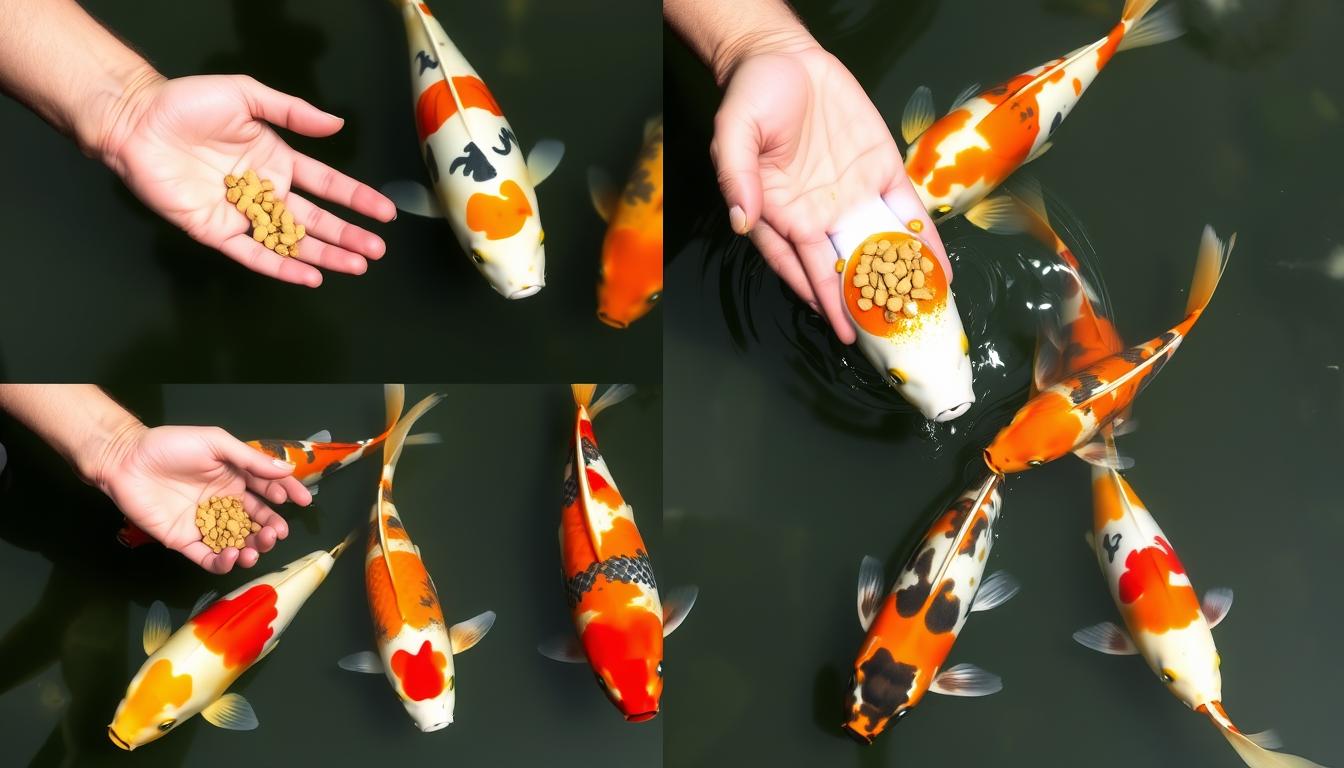
Hand-feeding koi is a gradual process that requires patience. Follow these steps to successfully train your koi to eat from your hand:
- Establish a Routine – Feed at the same time and same spot every day so your koi learn to expect you
- Start at a Distance – Begin by standing back from the pond and tossing food in, gradually moving closer over days or weeks
- Use a “Dinner Bell” – Create a consistent signal, like tapping lightly on the pond edge, to announce feeding time
- Introduce Your Hand – Once koi are comfortable with your presence, place your hand on the water’s surface without food first
- Offer Food From Above – Hold food above the water where koi can see it, then gradually lower it to the surface
- Submerge Your Hand – Place your hand with food just below the surface, keeping your palm flat and fingers together
- Release Small Amounts – Let a few pellets escape from your fingers to attract the fish closer
- Remain Still – Once koi approach, avoid sudden movements that might startle them
- Reward the Brave – When the first fish takes food from your hand, release more to reinforce the behavior
- Practice Regularly – Consistent, short sessions work better than infrequent, long ones
“Patience turns fish into friends”
Hand Positioning Tips
How you position your hand can make a significant difference in your success:
- Keep your palm flat with fingers slightly together
- Submerge your hand just enough to cover your palm with water
- Position yourself so you don’t cast a shadow over the feeding area
- For deeper ponds, try feeding from a seated position at the edge
- Keep your movements slow and deliberate to avoid startling the fish
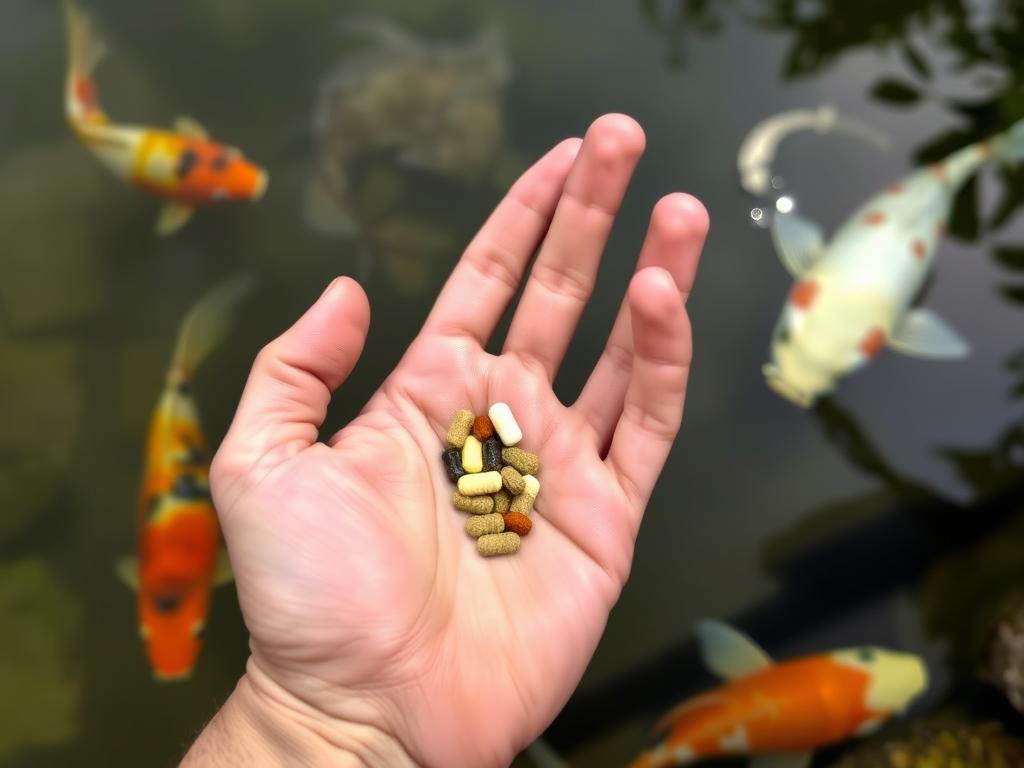
Building Trust Over Time
Hand-feeding koi isn’t just about technique—it’s about building a relationship based on trust. This process takes time and consistency, but the rewards are well worth the effort.
Reading Koi Body Language
Understanding how your koi communicate helps you gauge their comfort level and adjust your approach accordingly:
Signs of Curiosity and Interest:
- Swimming toward you when you approach the pond
- Gathering near your regular feeding spot
- Following your hand movements from below
- Gentle nudging or bumping against your fingers
- Staying at the surface near your hand
Signs of Fear or Discomfort:
- Darting away when your shadow appears
- Staying at the bottom of the pond
- Quick, erratic swimming patterns
- Refusing to approach even with food present
- Approaching but then suddenly backing away
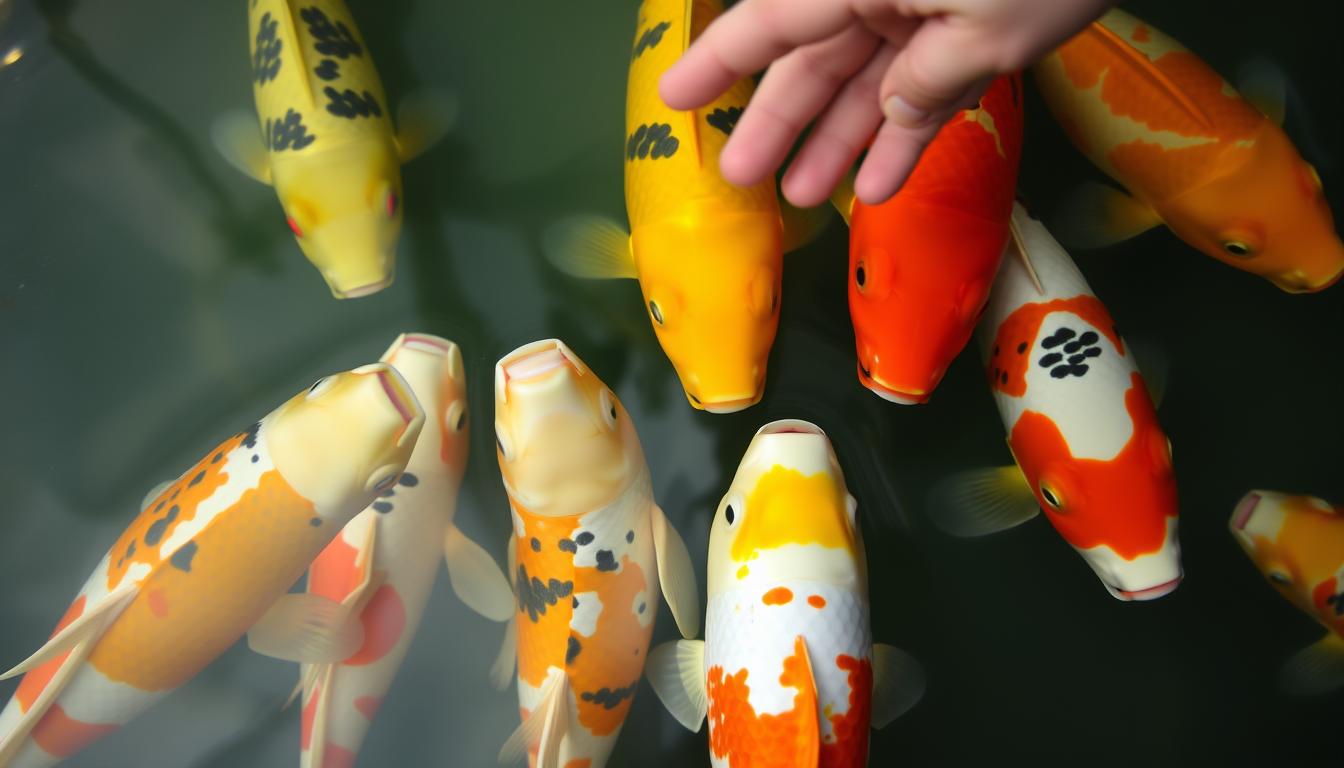
Consistency is Key
The most successful koi hand-feeders maintain consistent routines that build trust through predictability:
- Feed at the same times each day (typically morning and evening)
- Use the same approach and hand position each time
- Start each feeding session with your “dinner bell” signal
- Wear similar clothing to maintain a consistent appearance
- Keep feeding sessions short but frequent (5-10 minutes is ideal)
Remember that each koi has its own personality. Some may never become comfortable with hand-feeding despite your best efforts, while others might eat from your hand on the first try.
Safety Tips for You and Your Koi
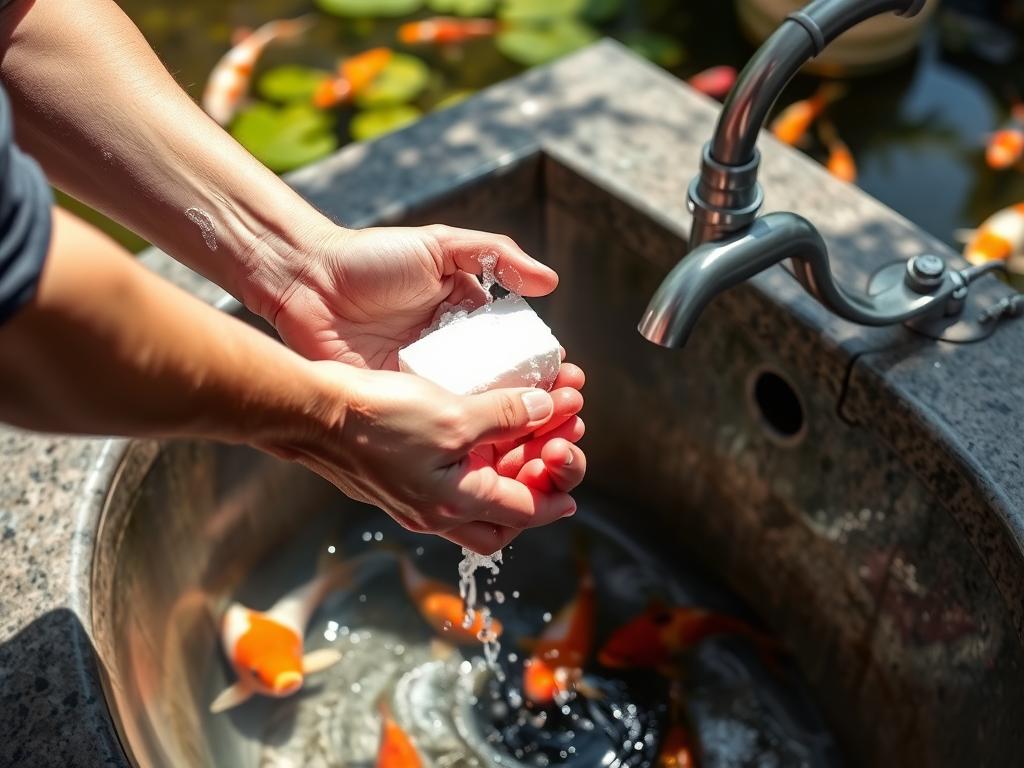
Hand-feeding should be a safe, enjoyable experience for both you and your fish. Follow these safety guidelines to protect your koi’s health and your enjoyment:
For Your Koi’s Safety:
- Wash your hands thoroughly before feeding to remove soaps, lotions, and chemicals
- Avoid hand-feeding if you’ve applied insect repellent, sunscreen, or hand sanitizer
- Remove rings, bracelets, and watches that could scratch or injure fish
- Never chase or try to grab your koi
- Feed only the appropriate amount for your pond size and fish count
For Your Safety and Comfort:
- Use a kneeling pad if feeding from the edge to protect your knees
- Consider using a small stool to sit comfortably at pond level
- Wear a hat and sunscreen for sun protection during feeding sessions
- Wash hands after feeding to remove pond water and fish slime
- Keep a towel nearby for drying your hands
Common Concerns Addressed
Do koi have teeth that can bite me?
Koi do have teeth, but they’re located far back in their throats (pharyngeal teeth) and are used for grinding food, not biting. When koi take food from your hand, you’ll feel a gentle sucking or tugging sensation, but they cannot bite your fingers.
Will touching koi remove their protective slime coat?
Brief contact during hand-feeding won’t significantly damage the slime coat. However, avoid excessive handling or touching the fish’s body. Let them come to your hand rather than trying to touch or pet them.
Is it safe to hand-feed in all seasons?
Hand-feeding should only be done during active feeding seasons when water temperatures are above 50°F (10°C). In colder temperatures, koi’s digestive systems slow down, and feeding can cause health problems.
Never overfeed koi. Feed only what they can consume in 5 minutes, and remove any uneaten food to maintain water quality.
Advanced Hand-Feeding Techniques
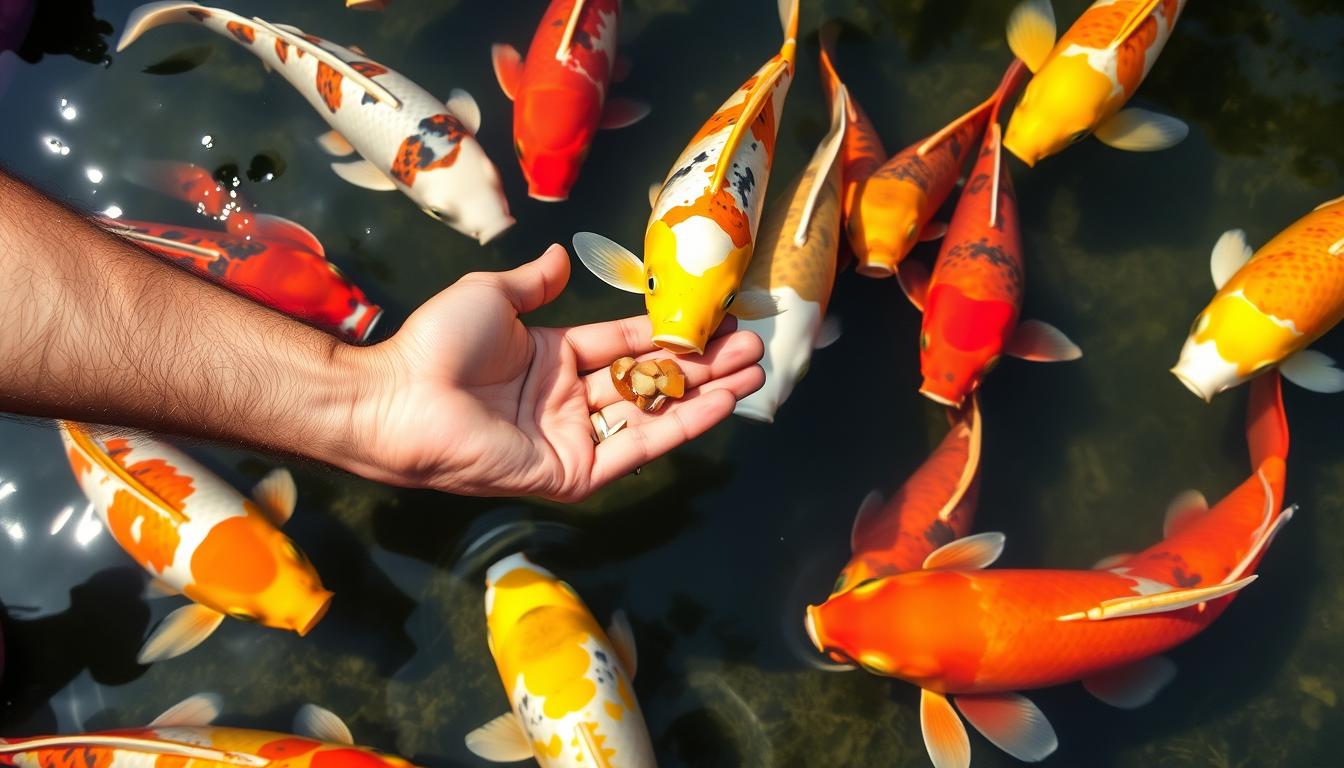
Once your koi are comfortable eating from your hand, you can explore more advanced interactions that deepen your bond:
Training Individual Koi
With patience, you can train specific koi to respond to unique signals:
- Use different tapping patterns for different fish
- Hold food in specific positions to encourage certain fish to approach
- Try feeding with both hands to accommodate more fish
- Practice identifying and naming individual koi based on their patterns
Introducing New People
Once your koi are comfortable with you, you can gradually introduce friends and family to the hand-feeding experience:
- Have the new person observe several feeding sessions first
- Start with the new person standing beside you during feeding
- Have them offer food while you keep your hand in the water nearby
- Gradually allow them to feed independently once the fish show comfort

Hand-feeding koi can become a cherished family activity that creates lasting memories, especially for children who delight in the direct interaction with these beautiful fish.
The Benefits of Hand-Feeding Your Koi
The practice of hand-feeding offers numerous rewards that enhance both your koi’s wellbeing and your enjoyment of the hobby:
Health Monitoring
Regular hand-feeding sessions allow you to closely observe each fish’s appearance and behavior, making it easier to spot potential health issues early. You’ll notice changes in appetite, color, or swimming patterns that might indicate problems.
Stress Reduction
The meditative quality of hand-feeding provides a peaceful break from daily stress. Many koi keepers describe their feeding sessions as calming rituals that help them slow down and connect with nature.
Enhanced Pond Experience
A pond with hand-fed koi becomes an interactive feature rather than just a visual element. Your koi will recognize and greet you, creating a living connection to your garden space.
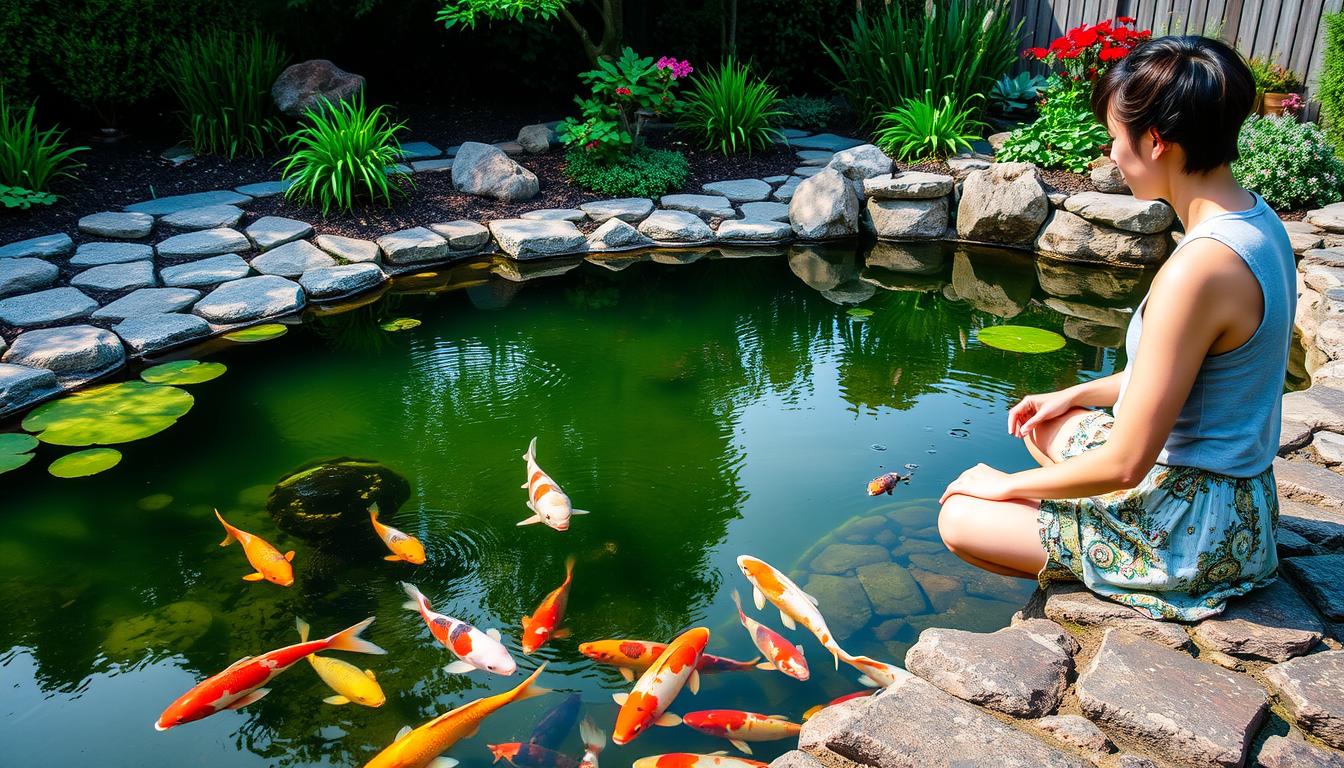
Take Your Koi Experience to the Next Level
Join our community of koi enthusiasts and receive weekly tips on koi care, feeding, and building stronger bonds with your fish. Plus, get exclusive discounts on premium koi food and supplies.
Troubleshooting Common Hand-Feeding Challenges
Even with the best techniques, you may encounter some challenges when training your koi to hand-feed. Here are solutions to common issues:
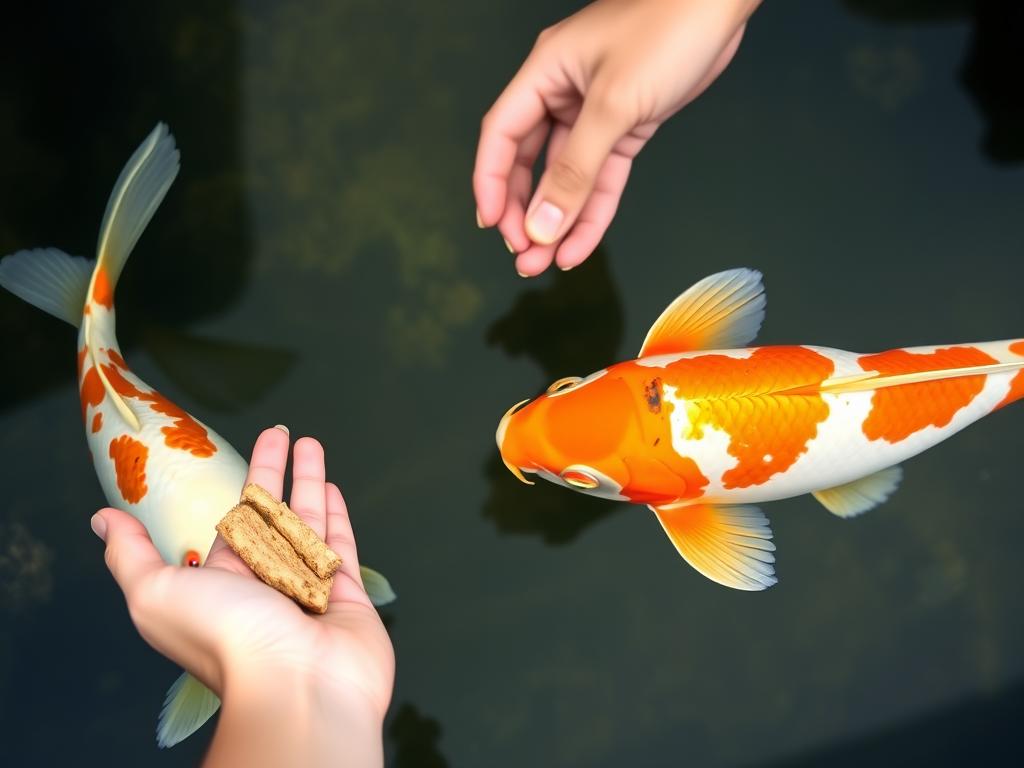
Common Problems
- Shy Fish: Some koi remain too timid to approach your hand
- Aggressive Feeding: Certain koi dominate and prevent others from feeding
- Inconsistent Response: Koi eat from your hand some days but not others
- Quick Retreats: Fish approach but dart away at the last moment
- Seasonal Changes: Koi that were hand-feeding stop during seasonal transitions
Solutions
- Introduce a “leader” fish like Chagoi that can show others it’s safe
- Feed in deeper water where multiple fish can approach from different angles
- Maintain strict consistency in timing, location, and approach
- Ensure you’re not casting shadows or making sudden movements
- Adjust feeding frequency based on water temperature and seasonal behavior
If your koi suddenly stop hand-feeding after previously accepting it, check water quality parameters. Changes in ammonia, nitrite, pH, or oxygen levels can affect koi behavior and appetite.
Start Your Hand-Feeding Journey Today
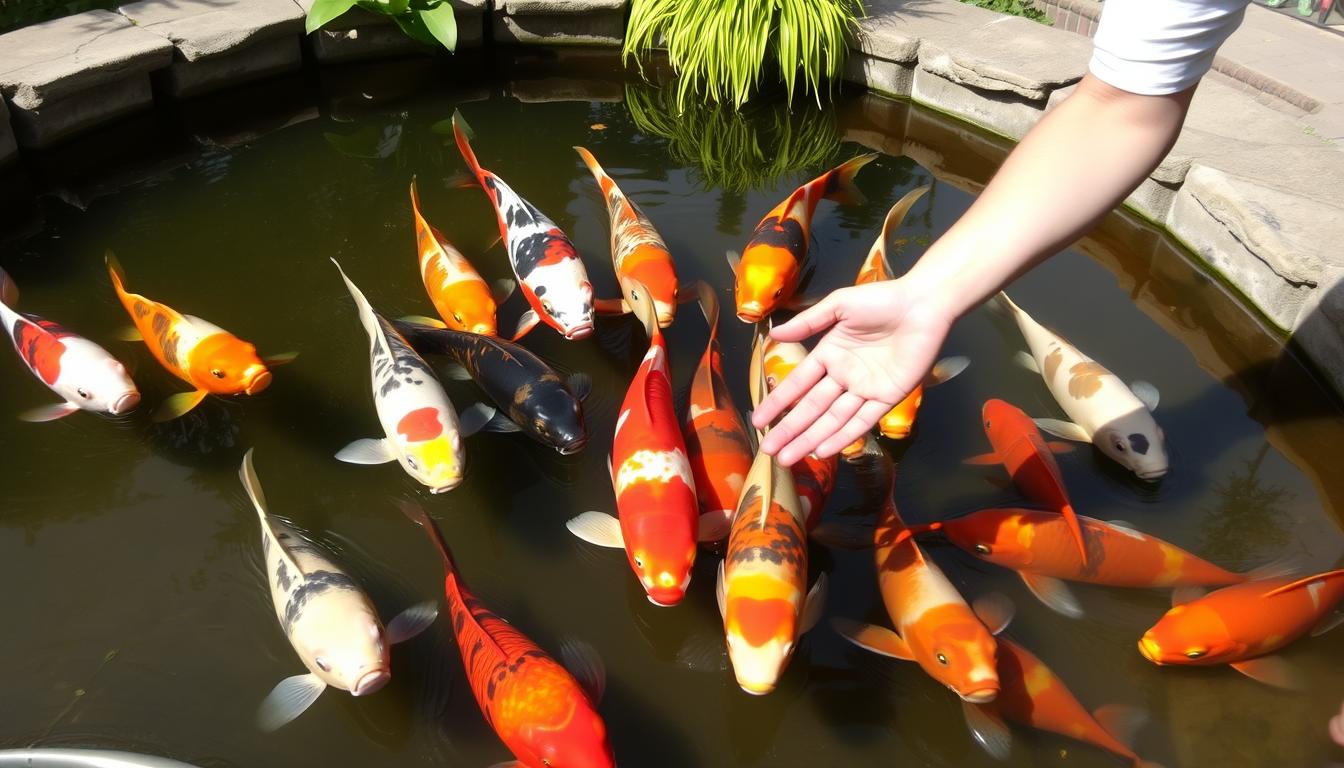
Hand-feeding koi is one of the most rewarding aspects of keeping these magnificent fish. The process transforms your relationship from distant observer to trusted friend, creating a unique bond that enhances both your life and the lives of your koi.
Remember that success comes with patience and consistency. Start with short, regular sessions and celebrate small victories along the way. Keep a journal of your progress, noting which fish approach first and how their behavior changes over time.
Whether you’re a new koi keeper or have maintained a pond for years, hand-feeding offers a deeper connection to these intelligent, beautiful creatures. The moment when a shy koi finally takes food from your palm is truly magical—a testament to the trust you’ve built and the relationship you’ve formed.
“The koi that eat from your hand today may swim with your grandchildren tomorrow.”
Begin your hand-feeding journey today, and discover the joy of connecting with your koi on a whole new level. With each feeding session, you’ll not only nourish your fish but also feed your soul with moments of tranquility and connection to the natural world.
Ready to Start Hand-Feeding Your Koi?
Get everything you need to begin your hand-feeding journey, from premium floating food to helpful training tools. Our starter kit includes a feeding guide, premium koi pellets, and a feeding ring to help concentrate your fish.
